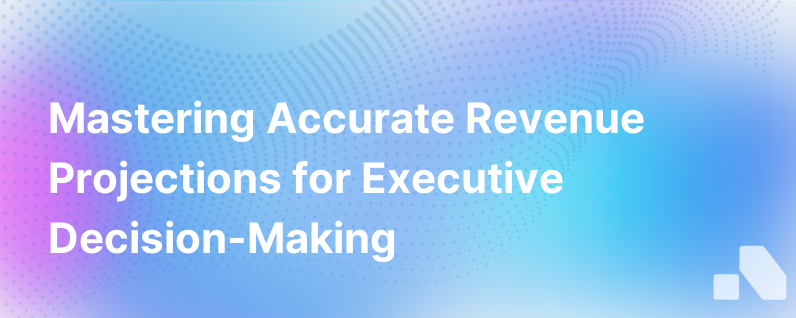How To Calculate Revenue Projections Accurately
Published on December 31, 2023 by David Zhang
Creating accurate revenue projections is a linchpin for the success of any business. It’s an integral process that informs decisions regarding growth strategies, budget allocations, staffing, and feasibility of upcoming projects.
In this extensive guide, let's explore how you can approach revenue projection with a comprehensive, analytical mindset to help fortify your business’ financial health and ensure you're on the right path towards your desired financial future.
Understanding the Importance of Revenue Projection
Revenue projections, often referred to as revenue forecasting, is the process by which businesses estimate the amount of revenue they expect to earn in the future. This forecast can span a variety of time frames -- typically, businesses project revenue monthly, quarterly, or annually.
These projections help businesses:
- Make informed decisions about budgets, spending, and investments
- Set realistic targets for sales teams
- Determine whether they need additional capital or financing
- Predict cash flow and avoid liquidity issues
- Plan for business growth and expansion
- Instill confidence in investors and stakeholders
While revenue projections never guarantee future earnings, accurate forecasting serves as a crucial navigational tool for business planning.
How To Calculate Revenue Projections Accurately
Accurate revenue projections rely on a mix of historical data, market analysis, and understanding of current sales pipelines. Here’s a comprehensive guide on how to create these projections:
1. Investigate Historical Performance
The best starting point for revenue forecasting is to look at your historical sales data. By analyzing patterns and trends from the past, particularly from the same period in previous years, you can predict future sales performance with greater accuracy.
To do this:
- Collect past sales data, segmenting it on a monthly, quarterly, and yearly basis.
- Identify seasonal trends, periods of growth or decline, and any outliers.
- Adjust for one-time events that are unlikely to repeat (like an unprecedented global event or a major contract that has now concluded).
2. Analyze the Sales Pipeline
Your current sales pipeline is a rich source of information for forecasting. Reviewing the number of potential deals and their respective stages can help you estimate the likelihood of conversion.
Here's how to analyze the pipeline:
- Assign probabilities to each stage of the pipeline based on historical conversion rates.
- Use weighted averages to forecast potential revenue from these leads.
- Account for the average length of your sales cycle to predict when each stage might translate into realized revenue.
3. Integrate Market Trends and Industry Data
Understanding the marketplace plays a critical role in revenue projection. Here’s how to incorporate this data:
- Carry out market research to discern industry trends, economic forecasts, and consumer behavior shifts.
- Take into account information like market saturation, new entrants, and regulatory changes.
- Benchmark against competitors where possible to gauge market share potential.
4. Calculate Revenue Projections
Now, combine your historical data, pipeline analysis, and market research to formulate your projections:
Historical Sales Performance Break down historical data into growth patterns and apply these patterns to the current period. For example:
Previous Quarter's Revenue * (1 + Historical Growth Rate) = Projected Revenue
Sales Pipeline Forecasting Estimate the value of each deal in the pipeline and multiply it by the probability of closure:
Sum of (Each Deal’s Value * Closure Probability) = Estimated Revenue from Pipeline
Market-Based Forecasting Adjust your figures based on macroeconomic and industry-specific conditions:
Historical & Pipeline-Based Projection * Market Adjustment Factor = Market-Adjusted Revenue Projection
5. Consider Recurring Revenue
If you have subscriptions or contracts providing recurring revenue, factor these into your projections:
- Begin with the current recurring revenue base.
- Add anticipated new recurring sales.
- Subtract likely churn based on historical averages.
6. Factor in Business Changes
Include anticipated changes within your business that could impact future sales:
- Plans for launching new products or entering new markets
- Expansion or downsizing of the sales team
- Pricing changes or special promotions
- Strategic partnerships or collaborations
7. Perform Sensitivity Analysis
Prepare for different scenarios by adjusting variables and assessing risk:
- Conduct best-case, worst-case, and most likely scenarios to reflect varying conditions.
- Test how changes in market conditions or internal factors affect projections.
8. Document Assumptions and Rationale
Clear documentation helps validate your methodology:
- List all assumptions behind the forecast.
- Note any sources used for external data.
- Provide explanations behind the calculations.
9. Review and Adjust Regularly
Revenue projection is not a one-time task. It should be ongoing:
- Monitor actual sales against projections.
- Adjust assumptions and methods as new data and insights are acquired.
The Bottom Line
Accuracy in revenue projection comes from a careful blend of science and educated guesswork. Given that no forecast can be perfect, the goal is to minimize the margin of error by applying a methodical approach that considers historical data, real-time statistics, market trends, and your specific business dynamics.
Engaging in frequent, structured forecasting exercises allows businesses of all sizes to allocate resources smartly, plan for future growth, and maintain financial stability amid the unpredictable nature of business.
While the process of creating accurate revenue projections can be detailed and complex, leveraging these steps ensures you have a robust framework in place. For an AI-driven approach to gathering and interpreting the pertinent data, tools like Aomni can be instrumental in demystifying this crucial task. With the right mix of data, insight, and technology, you can navigate towards a more predictable and profitable business future.